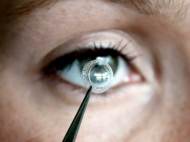Two types of artificial cornea being developed
 Blindness is often caused by corneal diseases which are usually treated with a corneal transplant, but in many cases this is not possible and donor corneas are often hard to come by. In order to solve this problem, a group of researchers from the Fraunhofer Institute for Applied Polymer Research (Fraunhofer IAP) is developing two different types of artificial corneas that could be used to save the vision of those people.
Blindness is often caused by corneal diseases which are usually treated with a corneal transplant, but in many cases this is not possible and donor corneas are often hard to come by. In order to solve this problem, a group of researchers from the Fraunhofer Institute for Applied Polymer Research (Fraunhofer IAP) is developing two different types of artificial corneas that could be used to save the vision of those people.
Fraunhofer IAP’s Dr. Joachim Storsberg collaborated with interdisciplinary teams and private companies to develop an artificial cornea between 2005 and 2009. The project was focused on development of artificial cornea for patients whose cornea had become clouded – a condition that is extremely difficult to treat. Such patients are unable to accept a donor cornea either due to their condition or due to previous unsuccessful transplantation attempts.
ArtCornea is a type of artificial cornea suitable as an alternative to a donor cornea in cases where the patient would not tolerate a donor cornea. It is based on a polymer with high water-absorbent properties, and its surface has a coating to ensure anchorage in host tissue and improved optic functionality. The edge of the ArtCornea is chemically altered to encourage local cell growth. These cells attach to the surrounding human tissue, thus fixing the device in the host tissue. The researchers aimed to enlarge the optical surface area of the implant in order to improve light penetration beyond what had previously been possible.
“Once ArtCornea is in place, it is hardly visible, except perhaps for a few stitches. It’s also easy to implant and doesn’t provoke any immune response”, said Storsberg.
ACTO-TexKpro is the other type of artificial cornea developed by the Fraunhofer IAP researchers which is suitable as a preliminary treatment, for instance if the cornea has been destroyed as a consequence of chronic inflammation, a serious accident, corrosion or burns. It is based on a chemically and biologically inert base material which is biologically compatible.
Dr. Storsberg achieved this by selectively altering the base material, polyvinylidene difluoride, by coating the fluoride synthetic tissue with a reactive molecule. This allows the patient’s cornea to bond together naturally with the edge of the implant, while the implant’s inner optics, made of silicon, remain free of cells and clear.
The experiments were carried out in collaboration with Dr. Norbert Nass and Dr. Saadettin Sel, Senior consultant ophthalmologist at Martin-Luther-University Halle-Wittenberg. ACTO-TexKpro and ArtCornea were first tested by the doctors in the laboratory, and afterward in vivo in several rabbits. After a six month healing process, the implanted prostheses were accepted by the rabbits without irritation, clearly and securely anchored within the eye. Tests carried out following the operation showed that the animals tolerated the artificial cornea well.
Dr. Norbert Schrage will take charge of clinical trials which are expected to commence soon at the Ophthalmic Clinic Cologne-Merheim.









Leave your response!